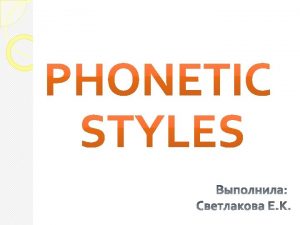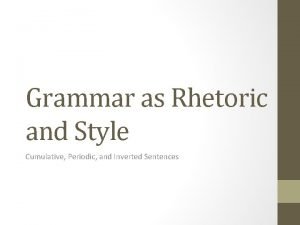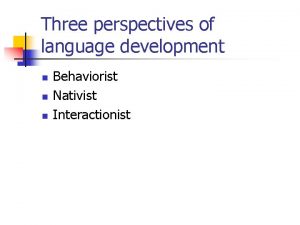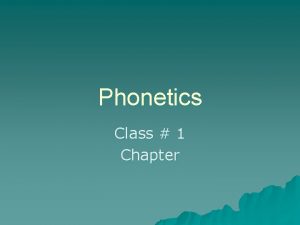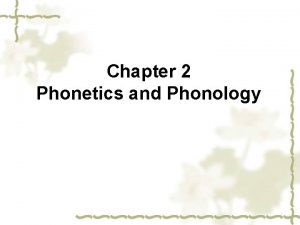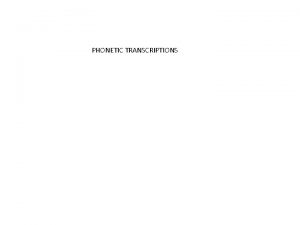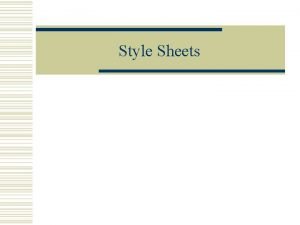Contents 1 Phonetic peculiarities of style 2 Styleforming















- Slides: 15


Contents � 1. Phonetic peculiarities of style � 2. Style-forming and style-modifying factors � 3. Classifying phonetic styles

Phonetic peculiarities of style �When used in speech phonetic units undergo various changes under the influence of extralinguistic factors. The bundle of these factors forms the extralinguistic situation. The extralinguistic situation determines the choice of language means, phonetic means in particular.

Phonostylistics �Phonostylistics is a branch of phonetics which studies the way phonetic units (both segmental and suprasegmental) are used in particular extralinguistic situations. It is concerned with the identification of style-forming means, i. e. The phonetic features that enable the native speaker to distinguish intuitively between different styles of pronunciation.

The extralinguistic situation � The extralinguistic situation can be described in terms of three components, i. e. purpose, participants and setting. These components distinguish situations as the context in which speech interaction takes place. � Purpose is the most important factor that guides the communication. It is the task that is achieved in the course of communication. � Participants are people involved in communication. Speech is a marker of various characteristics of people, both individual and social: age, gender, family background, occupation, social roles.

The scene (setting) � The scene (setting) includes the physical orientation of participants, which is connected with the type of speech activity they are engaged in. Scenes can also be described in the following terms: public – non-public (private), formal – informal, monologuing – dialoguing – poliloguing. The channel of communication is also to be taken into consideration: face-to-face interaction – telephone communication, mass media communication.

Style-forming and style-modifying factors �The extralinguistic factors, that determine the choice of phonetic means and result in phonostylistic variation are: – the purpose, or aim of communication; – the degree of formality of the situation; – the degree of spontaneity; – the speaker’s attitude.

The aim of communication �The purpose, or aim of communication may be called a style forming factor, while all the others cause modifications within a particular style, which account for the existence of different kinds and genres of texts within each phonetic style. All the factors are interdependent and interconnected.

Factors of stylistic variations of sounds and intonation �Stylistic variations of sounds and intonation result from different combinations of extralinguistic factors. Stylistic modifications of sounds are caused primarily by the degree of formality, while variations of intonation are basically determined by the aim of communication.

Segmental and prosodic style-forming means � Each style of pronunciation is characterized by a relatively high proportion of definite segmental and prosodic features which are not typical of other styles. If some of them are used in other styles, they occur not as often and in combination with other features. Therefore each phonetic style is characterized by a specific combination of certain segmental and prosodic features. � Segmental style-forming means: the degree of assimilation, reduction, elision. � Prosodic style-forming means: departure from a norm of loudness, tonal variation, variations of pitch levels, departure from a normal tempo, pauses.

Formal and informal situations �In formal situations pronunciation tends to be careful and is characterized by articulatory precision. In informal situations speech is generally faster and less careful. In informal casual discourse (fast colloquial speech) the processes of simplification take place: assimilation, reduction, elision. �Each of the five phonetic styles is used in a particular sphere of discourse and is characterized by a set of prosodic features, which in their combination form the model of the phonetic style.

Classifying phonetic styles � All existing classifications are based on different principles. They differ in the number of styles which are singled out. Some principles of classifications of pronunciation styles are: � the degree of carefulness; � the extent of formality; � the rate of speech; � the social situations; � the phonetic features and other linguistic characteristics of the numerous varieties of speech forms and the extent of formality (S. Gaiduchik).

The classification based on the purpose of communication � The classification of phonetic styles is based on the purpose of communication, which is the most significant extralinguistic factor. Five phonetic styles can be singled out according to the purpose of communication: 1. Informational style; 2. Academic (Scientific) style; 3. Publicistic (Oratorial) style; 4. Declamatory (Artistic) style; 5. Conversational (Familiar) style.

Classification by S. Gaiduchik There now appear to be an increasing body of evidence to support the view that scholars should distinguish between 1) phonetic styles of spontaneous speech (conversation, spontaneous monologue, etc. ); 2) phonetic styles of prepared speech (lectures, speeches, etc. ); 3) phonetic styles of reading aloud. � In their turn, the phonetic styles of spontaneous speech should be classified into a) official style; b) informal style or the style of everyday-life discourse, and c) familiar (careless) style. � Each of these subgroups includes numerous varieties which are modified by extralinguistic factors. �

 Phonostylistics as a branch of phonetics
Phonostylistics as a branch of phonetics Cumulative sentence
Cumulative sentence Formal and informal writing style
Formal and informal writing style Referential vs expressive style
Referential vs expressive style Modified block format letter
Modified block format letter Inversion in poetry
Inversion in poetry Formal writing style examples
Formal writing style examples Phonetic drill
Phonetic drill Phonetic drill
Phonetic drill Odd phonetic transcription
Odd phonetic transcription Phonetic alphabet song military
Phonetic alphabet song military Classification of english vowels
Classification of english vowels Phoenitic alphabet a-z *
Phoenitic alphabet a-z * 2phonetics
2phonetics S phonetic alphabet
S phonetic alphabet Phonetic definiton
Phonetic definiton
